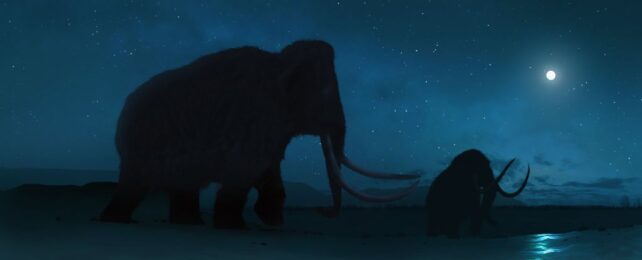For hundreds of thousands of years, the wooly mammoth thrived on Earth, measuring its stately tread across the frozen reaches.
Then, something happened. Earth changed. And in a remarkably short time, the mammoths (Mammuthus primigenius) were gone, the last of them dying out 4,000 years ago, on remote Wrangel Island in the cold Arctic north.
Though it's theorized humans contributed greatly to their eventual decline, it's not clear what factors may triggered the change in climate that put them in peril. One idea is that Earth was hit by a cosmic event nearly 13,000 years ago, warming the world beyond what was tolerable for mammoths and paving the way for other species to thrive.
This is called the Younger Dryas impact hypothesis (YDIH), and to call it highly controversial would perhaps be putting it mildly. Nevertheless, some scientists believe the idea has legs, and have been looking for evidence to support it.
One of those is archaeologist Christopher Moore of the University of South Carolina. "Some of our critics have said, 'Where's the crater?'" Moore says. "As of now, we don't have a crater or craters."
Nevertheless, Moore and his colleagues believe that the evidence can be found, if you conduct more than a surface investigation of Earth. And they also believe that they have found some of it – in the form of minerals with properties, they say, best explained by a cometary impact.
In their most recent paper, they describe several of these lines of evidence that in aggregate, they say, tell a compelling story.
These different pieces of evidence come from layers of sediment dug from sites around the world, all dated using radiocarbon analysis to around 12,800 years ago – the period in which the impact is thought to have taken place.
From roughly 50 sites around the world, including North and South America, Europe, Asia, and the Greenland ice sheet, clues have emerged that could be indicative of Earth meeting a comet.
In ice cores dug out of permanently frozen regions of Greenland, microparticles associated with widespread fires – so-called combustion aerosols that propagate throughout the atmosphere when matter burns – have been uncovered.
In samples take from other parts of the world, such as Syria, and three widely separated sites in North America, unusually high abundances of platinum can be found. Platinum, Moore explains, is rare in Earth's crust, but relatively common in comets.
In the same sedimentary layer is an elevated concentration of tiny, microscopic balls of iron called microspherules. These form when molten material sprays through the air, as occurs when a meteorite either impacts the surface or melts and explodes in the atmosphere.
And lastly, researchers report for the first time the presence of grains of shock-fractured quartz in the Younger Dryas boundary layer across a range of well-separated sites across North America. This is quartz that exhibits microscopic fractures as the result of a significant, well, shock.
"It's like putting 75 elephants on a quarter," Moore says. "It's a tremendous amount of pressure that creates what we're seeing."
The bigger picture that could emerge from these puzzle pieces is a comet that struck Earth around 12,800 years ago in an impact that may not have left a crater. If the comet exploded in the atmosphere, the resulting shockwave could have washed over the surface to produce all the observed elements, similar to the way the Tunguska event created a giant hubbub without leaving a deep scar in the planet's surface.
It is very far from a smoking gun, however. In a paper published in December of last year, a team led by anthropologist Vance Holliday of the University of Arizona noted, "Evidence and arguments purported to support the YDIH involve flawed methodologies, inappropriate assumptions, questionable conclusions, misstatements of fact, misleading information, unsupported claims, irreproducible observations, logical fallacies, and selected omission of contrary information."
So we're probably going to need a lot more data before the scientific establishment is even close to being convinced. Even still, other scientists point out that in the past many scientific theories that were once rejected or dismissed later received widespread consensus, so while it's important to remain skeptical, it can pay to keep an open mind.
What cannot be denied is that asteroid and comet impacts are absolutely worth investigating in connection with large scale environmental changes, if not to understand history than to help guide our decisions for tomorrow. These events have altered the course of all life on Earth before, and although the Solar System is a lot more calm than it once was, the possibility of another occurring in the future is not zero.
The new paper has been published in Airbursts and Cratering Impacts.
